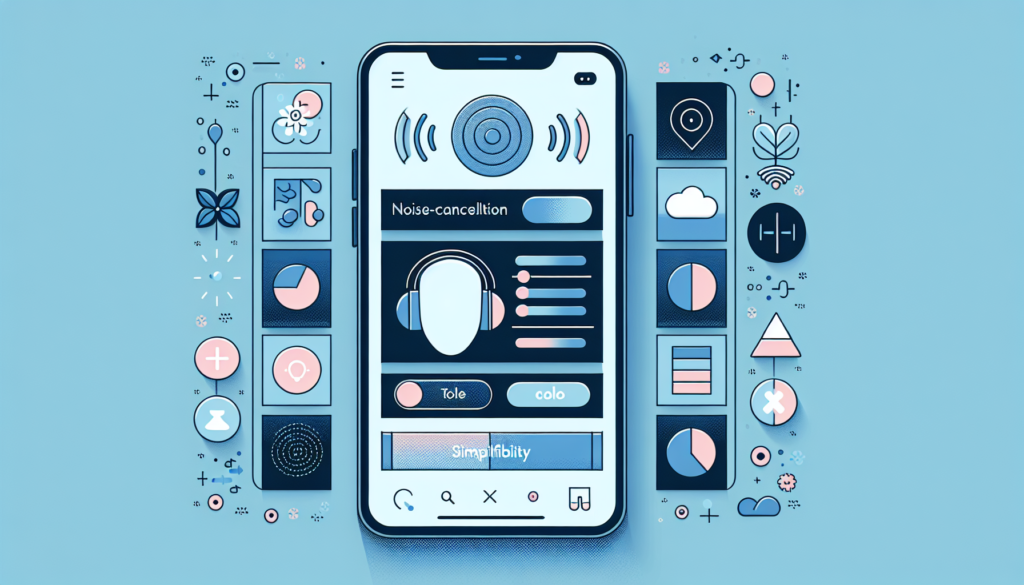Imagine if technology could be tailored to accommodate individuals with sensory sensitivities. Picture AI apps that understand and adapt to the unique needs of those with sensory challenges. In this article, we explore the question: are there sensory-friendly features in AI apps? Discover how advancements in artificial intelligence are revolutionizing the way technology interacts with our senses, paving the way for a more inclusive and accessible digital world. Discover the possibilities and potential benefits that await in the realm of sensory-friendly AI apps.

The Importance of Sensory-Friendly Features
As technology continues to advance, it is essential to ensure that it is accessible to all individuals, including those with sensory disabilities. Sensory-friendly features play a crucial role in making AI apps inclusive and usable for everyone. By incorporating these features, developers can create a more inclusive user experience and empower individuals with sensory impairments to interact with AI technology effectively.
Designing for Accessibility
Designing for accessibility means considering the specific needs and preferences of users with sensory disabilities. Sensory-friendly features aim to minimize barriers and create a more inclusive environment for all users. This approach is not only valuable for individuals with disabilities but also benefits the entire user base by improving usability and enhancing the overall user experience.
Benefits of Sensory-Friendly Features
Implementing sensory-friendly features in AI apps has numerous benefits. Firstly, it allows individuals with sensory impairments to access and engage with technology on an equal basis with others. This inclusivity promotes independence, enhances social participation, and improves overall quality of life.
Secondly, sensory-friendly features can enhance the usability and functionality of AI apps for all users. For example, adjustable color schemes can provide a more comfortable viewing experience for individuals with visual impairments, but they can also benefit individuals without disabilities who may prefer different color combinations or have sensitivity to certain colors.
Lastly, incorporating sensory-friendly features can lead to a positive user experience and increase user satisfaction. By addressing the specific needs of users with sensory disabilities, AI apps can build a loyal user base that appreciates and values the inclusivity and usability of the technology.
Understanding Sensory-Friendly Features
What Are Sensory-Friendly Features?
Sensory-friendly features refer to design elements, functionalities, and customization options that aim to accommodate the sensory preferences and needs of individuals with sensory impairments. These features are specifically tailored to address challenges related to vision, hearing, or sensory processing disorders, allowing users to navigate, interact, and engage with AI apps in a way that suits their specific sensory requirements.
Common Types of Sensory-Friendly Features
-
Text-to-Speech Functionality: Text-to-speech functionality is a common sensory-friendly feature in AI apps that converts written text into spoken words. This feature is particularly helpful for individuals with visual impairments as it allows them to access and comprehend the content without depending solely on visual cues.
-
Adjustable Color Schemes: Adjustable color schemes enable users to customize the app’s color palette, ensuring optimal visual contrast and readability for individuals with visual impairments or color sensitivity. Users can select color combinations that best suit their preferences and needs, promoting a more comfortable and accessible user experience.
-
Integration of Speech Recognition: The integration of speech recognition enables individuals with mobility or motor impairments to interact with AI apps through voice commands instead of manual input. This feature empowers users to navigate through the app, access information, and perform tasks effectively, regardless of their physical limitations.

Sensory-Friendly Features in AI Apps
AI apps can further enhance their inclusivity by integrating various sensory-friendly features that cater to the needs of individuals with sensory impairments. These features can significantly improve the usability and accessibility of the technology, promoting equal opportunities for all users.
Integration of Speech Recognition
The integration of speech recognition technology allows users to interact with AI apps using their voice. By simply speaking commands or requests, individuals with mobility or motor impairments can navigate through the app, perform tasks, and access information effortlessly. This feature promotes inclusivity and independence by eliminating the need for manual input and allowing individuals with physical disabilities to fully utilize the app’s functionalities.
Text-to-Speech Functionality
Text-to-speech functionality is another essential sensory-friendly feature in AI apps. This feature converts written text, such as articles, notifications, or menus, into spoken words, allowing individuals with visual impairments to access and comprehend information. By providing auditory feedback, AI apps with text-to-speech functionality ensure that individuals with visual impairments can engage with the content and functionalities of the app effectively.
Adjustable Color Schemes
Adjustable color schemes are a valuable sensory-friendly feature that benefits individuals with visual impairments, color blindness, or sensitivity to specific colors. By allowing users to customize the app’s color palette, AI apps can ensure optimal visual contrast, readability, and overall accessibility. Users can select color combinations that best suit their needs and preferences, enhancing their comfort and usability while interacting with the app.
Customization Options for Sensory-Friendly Experience
AI apps can provide personalized and customizable options that cater to individual sensory needs, further enhancing the accessibility and usability for users with sensory impairments. These customization features allow users to tailor their experience according to their specific needs and preferences.
Personalized Sound Settings
Personalized sound settings enable users to adjust the volume, pitch, or speed of audio cues in AI apps. This feature is particularly useful for individuals with hearing impairments as it allows them to optimize the sound output according to their hearing abilities. By personalizing the sound settings, users can ensure that they receive auditory feedback at a level that is comfortable and easy for them to perceive.
Adjusting Visual Effects
Customization options that allow users to adjust visual effects within AI apps can greatly benefit individuals with visual impairments or sensory processing disorders. Users can modify the brightness, contrast, or animations to create an environment that is suitable for their specific visual needs. This customization ensures that the app’s visual elements are comfortable and accessible, allowing users to effectively engage with the content and functionalities.
Customizable Interface Layout
Customizable interface layouts provide users with the flexibility to arrange and organize the elements within the AI app according to their individual preferences. This feature can benefit individuals with sensory processing disorders or cognitive impairments, allowing them to simplify or declutter the interface. By customizing the interface layout, users can create a more sensory-friendly environment that reduces distractions and enhances their ability to navigate and interact with the app.
Assistive Technologies for Sensory-Friendly Interactions
In addition to the sensory-friendly features directly incorporated into AI apps, assistive technologies can also contribute to creating a more inclusive and accessible user experience. These technologies complement AI apps, enabling individuals with sensory impairments to interact effectively and independently.
Screen Readers
Screen readers are assistive technologies that use synthesized speech or braille output to convey the information displayed on a screen. By translating the text into speech or braille, individuals with visual impairments can access the content and functionalities of AI apps. These screen readers ensure that individuals with visual impairments can navigate through menus, read articles, and interact with the app’s features.
Gesture Recognition
Gesture recognition technology allows individuals with limited fine motor skills or mobility impairments to interact with AI apps using intuitive hand movements or gestures. By analyzing the user’s hand gestures, these technologies can interpret and execute commands, providing an alternative input method for individuals who may struggle with traditional touch or keyboard inputs. Gesture recognition technology enables users to navigate within the app, select options, and perform tasks, expanding the accessibility of AI apps to a broader user base.
Voice Assistants
Voice assistants, such as Siri, Google Assistant, or Alexa, are AI-powered technologies that respond to voice commands and perform various tasks. These voice assistants can be integrated into AI apps, allowing individuals with sensory disabilities to interact with the app using natural language and spoken commands. By providing voice-controlled access, individuals with motor impairments, visual impairments, or sensory processing disorders can effectively engage with the features and functionalities of the app.
Challenges and Considerations in Implementing Sensory-Friendly Features
While incorporating sensory-friendly features into AI apps offers numerous benefits, developers should also be aware of the challenges and considerations involved in the implementation process. It is crucial to address these challenges to ensure that the features are seamlessly integrated and provide a positive user experience.
Ensuring Compatibility with Different Devices
One of the primary challenges in implementing sensory-friendly features is ensuring compatibility across various devices and platforms. AI apps should be responsive and adaptable to different operating systems, screen sizes, and device capabilities. Developers must thoroughly test the app’s performance on different devices to ensure that the sensory-friendly features function reliably and provide a consistent user experience across the board.
Addressing Privacy and Security Concerns
AI apps often rely on collecting personal user data, such as voice recordings or user preferences, to personalize the experience and improve functionality. While collecting this data is necessary for effective implementation of sensory-friendly features, it is crucial to prioritize privacy and security. Developers must implement robust security measures to protect user data and ensure that it is used only for its intended purposes.
Balancing Aesthetics and Functionality
When incorporating sensory-friendly features, maintaining a balance between aesthetics and functionality is essential. While the focus is on improving accessibility and usability, developers should ensure that the design and user interface remain visually appealing and engaging. The colors, graphics, and visual elements should be carefully chosen to provide maximum accessibility without compromising the app’s overall aesthetics.
Examples of AI Apps with Sensory-Friendly Features
AI apps encompass a wide range of functionalities, and numerous examples exist that integrate sensory-friendly features to cater to specific sensory disabilities. These examples demonstrate the effectiveness of incorporating these features and the positive impact they have on users’ daily lives.
AI Apps for Individuals with Visual Impairments
Apps like Seeing AI, Voice Dream Reader, and Be My Eyes are designed to assist individuals with visual impairments. These apps incorporate a variety of sensory-friendly features such as text-to-speech functionality, magnification tools, and color customization options. Users can leverage these features to access information, read documents, and navigate their surroundings more effectively.
AI Apps for Individuals with Hearing Disabilities
AI apps like Ava, Live Transcribe, and Sound Amplifier are designed to facilitate communication and accessibility for individuals with hearing disabilities. These apps utilize speech recognition technology, real-time transcription, and personalized sound settings to enhance communication and ensure individuals with hearing impairments have equal access to information and conversations.
AI Apps for Individuals with Sensory Processing Disorders
Apps like Sensory App House, Special iApps, and myHACCP utilize sensory-friendly features to assist individuals with sensory processing disorders. These apps include customizable visuals, sound settings, and interface layouts to create a tailored and comfortable user experience. Users can adjust the app’s settings to suit their specific sensory needs and preferences, enabling them to engage and interact effectively.
User Feedback and Improvement in Sensory-Friendly Features
User feedback plays a crucial role in the continuous enhancement and improvement of sensory-friendly features in AI apps. By actively seeking feedback, developers can gain insights into the effectiveness of the implemented features and understand user preferences and needs. This feedback allows developers to make informed updates and adjustments to further optimize the accessibility, usability, and overall user experience.
Importance of User Feedback
User feedback provides valuable firsthand insights into the effectiveness of sensory-friendly features. By listening to user experiences and suggestions, developers can identify areas for improvement and gain a deeper understanding of specific user requirements. User feedback ensures that the features are aligned with the needs of the user base, leading to a more inclusive and satisfying user experience.
Continuous Enhancement and Updates
Based on user feedback, developers can continuously enhance and update sensory-friendly features in AI apps. User feedback helps uncover any usability issues, accessibility barriers, or areas that can be improved upon. By analyzing the feedback and implementing necessary changes, developers can iterate and refine the features, creating an environment that is more accommodating to a diverse range of sensory needs.
Future Trends and Innovations in Sensory-Friendly AI Apps
The future holds tremendous potential for further advancements and innovations in sensory-friendly AI apps. As technology continues to evolve, developers can leverage these advancements to enhance accessibility, user experience, and inclusivity.
Advancements in Natural Language Processing
Advancements in natural language processing can enable AI apps to better understand and interpret complex user commands and requests. This technology can further enhance the integration of voice assistants and speech recognition features, allowing individuals with sensory disabilities to interact with AI apps more efficiently and naturally.
Gesture-Based Interaction
Gesture-based interaction is an area with great potential for improving accessibility in AI apps. Advanced gesture recognition technologies can enable individuals with limited mobility or motor impairments to interact with apps using intuitive hand movements or gestures. By expanding the range of possible input methods, AI apps can become more versatile and accessible to a broader spectrum of users.
Virtual Reality Integration
The integration of virtual reality (VR) technology can revolutionize the sensory experience in AI apps. VR can recreate immersive environments that cater to individual sensory preferences and needs. For example, individuals with visual impairments can navigate and interact with AI apps using sound cues and haptic feedback. Virtual reality integration can open up new possibilities for individuals with sensory disabilities to engage with AI apps in a more immersive and accessible manner.
Conclusion
Sensory-friendly features play a vital role in making AI apps accessible and inclusive for individuals with sensory disabilities. By incorporating these features, developers can enhance usability, improve the overall user experience, and empower individuals with sensory impairments to effectively engage with AI technology. Personalized customization options, integration of assistive technologies, and continuous improvement based on user feedback are key factors in creating a more inclusive and accessible environment. As we look towards the future, advancements in technology will undoubtedly bring even more innovative solutions to further enhance the accessibility and functionality of AI apps for individuals with sensory disabilities.




